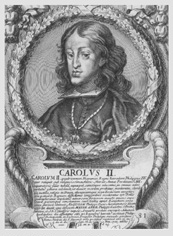Read The Good, the Bad and the Unready Online
Authors: Robert Easton
The Good, the Bad and the Unready (6 page)

 Bertie
Bertie
see
Edward the
CARESSER
 Charles the
Charles the
Bewitched
Charles II, king of Spain, 1661–1700

Charles the
Bewitched
The reign of Charles II of Spain seemed, for anyone unfortunate enough to be around at the time, interminable. When the king’s father, Philip IV, died, he left a four-year-old feebleminded epileptic as his heir and Spain desperately in need of a regent. Some misguided fools determined that Charles’s frequent drooling and convulsive fits indicated that he was possessed by the devil, giving rise to his nickname, ‘the Bewitched’. Confessors, exorcists and visionary nuns were dragooned from all corners of the kingdom to employ weird potions and conduct exorcisms in an attempt to cast out his supposed devil. Unfortunately for Charles, their efforts achieved only a rapid degeneration of his
condition, which left him spending much of his time in a blithering frenzy.
Everyone expected that Charles would die at a young age, but he confounded one and all by ruling, albeit in name only, for thirty-five long years. Given his condition, there was no hope of his wife, Marie Louise, producing an heir, and so his reign was suffused with plots about the succession. At first there were three candidates, an Austrian archduke, a French duke and a Bavarian prince. In February 1699, however, the Bavarian prince suddenly upped and died, leaving a head-to-head contest between Archduke Charles and his rival, Philip of Anjou.
Pathetically, Charles’s last days were spent participating in the politics of his successor, and during a rare lucid, frenzy-free period, he named Philip of Anjou, the grandson of Louis the
SUN KING
, as the sole heir to his dominion. Steadfast amid the howls of outrage made by the pro-Austrian factions of his court, Charles displayed a dignity on his deathbed that had eluded the unfortunate man in his lifetime.
 Big Alexander
Big Alexander
see
Alexander the
WOLF OF BADENOCH
 Bertha Bigfoot
Bertha Bigfoot
Bertrada, queen of the Franks, c.720–83
Wife of Pepin the
SHORT
and mother of Charles the
GREAT
(Charlemagne), Bertrada was also known as ‘Queen Goosefoot’ and, as such, was the possible inspiration for the name ‘Mother Goose’ of nursery-rhyme fame.
 Malcolm
Malcolm
Bighead
Malcolm III, king of Scotland, c.1031–93
Above all else, Malcolm loved two things: his wife and the clamour of battle. While Macbeth had been in power in Scotland, Malcolm had bided his time in England learning to speak English
and to like the English and their ways. Of all the English he met, however, Malcolm became absolutely besotted with a woman named Margaret, sister of Edgar the
OUTLAW
, the heir to the English throne, and he married her in 1069. He was so fond of her that he made English, rather than Gaelic, the official court language, kissed the books that she read, and agreed to her saintly demands to spend certain mornings every year washing the feet of six beggars and handing out food to nine orphans. Although it has been suggested that the nickname ‘Canmore’, stemming from the Gaelic words
ceann
meaning ‘head’ or ‘chief, and
mor
meaning ‘great’ or ‘big’, was ascribed to Malcolm because he was a swaggering bully, this was clearly not so when his wife was around.
Malcolm’s second love, as with most kings of the time, was fighting, and during his reign he led no fewer than five invasions into the northern part of England. In one of these expeditions it was said that ‘old men and women were slaughtered like swine for a banquet.’ After comparatively timid military responses from the English monarchs Edward the
CONFESSOR
and Harold the
LAST OF THE SAXONS
, Malcolm faced much tougher opponents in William the
CONQUEROR
and William
RUFUS
, to whom he eventually ceded Cumberland and by whose forces he was ultimately ambushed and killed. It has been suggested that Malcolm was nicknamed ‘Canmore’ because he was a ‘great chief. This appears not to have been the case all the time.
Little if any research has been conducted on whether the nickname actually refers to a physical attribute rather than a character trait – it could be that Malcolm simply had a really big head.
 Fulk the
Fulk the
Black
see
COLOURFUL CHARACTES
 Halfdan the
Halfdan the
Black
see
COLOURFUL CHARACTES
 Black Agnes
Black Agnes
Agnes, countess of Dunbar and March, c.1312–69
In 1338 Edward the
BANKRUPT
sent William Montague, the earl of Salisbury, to capture Dunbar Castle in East Lothian. It looked to be a comparatively simple task since the earl of Dunbar was away, fighting an English army in the north. But Edward and Salisbury had not anticipated the heroic spirit of the countess, whom the English later dubbed ‘Black Agnes’ for her complexion, hair colour and defiance.
